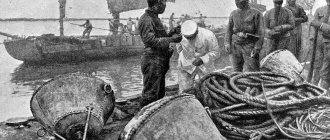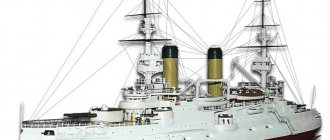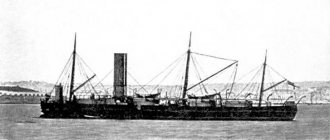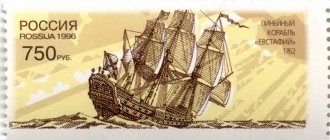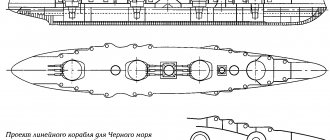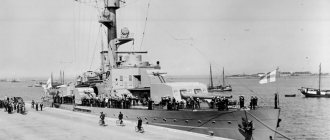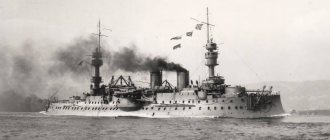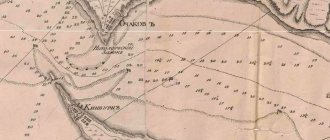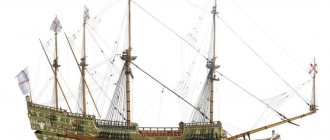Black Sea battleships: from Popovka to Potemkin
The Black Sea armored ships of the second half of the 19th - early 20th centuries went through a long evolutionary path - from the first small “popovkas” to huge squadron battleships that became the strongest ships on the Black Sea. The process of this evolution was influenced by many factors: continuous technological progress, the growing capabilities of Russian shipbuilding, the exorbitant ambitions of some senior naval officials, the constant lack of funds in the country’s budget and the eternal desire of officials to “save money.” As a result, over 34 years, ten ships were built, which formed the basis of the combat power of the Black Sea Fleet. We will tell you about them today.
"POPOVKI" - THE FIRST BLACK SEA ARMORED SHIPS
Crimean War 1853-1856 ended with the defeat of the Russian Empire. According to the Paris Peace Treaty, our country was deprived of the Black Sea Fleet, naval bases and fortresses on the Black Sea. It was only allowed to have a flotilla of 10 small ships. Emperor Alexander II began to carry out liberal reforms in the country, they also affected the Russian Imperial Navy. Construction of steam-powered armored coastal defense ships began in the Baltic. And in 1876, the first seaworthy battleship "Peter the Great" - the strongest warship in the world - joined the fleet. Construction of battleships begins. On the Black Sea everything was different.
The leadership of the Naval Ministry repeatedly planned to begin the construction of warships in the south. But each time the resolution of the issue was postponed due to various reasons: our country was forced to comply with international treaties, the treasury was chronically short of funds, there was not a single shipbuilding plant on the Black Sea that was ready to build a relatively large ship, and the military leadership did not could finally choose the design of an armored ship. Meanwhile, the Ottoman Empire was rapidly expanding its fleet.
At the end of 1870, when France was defeated by Prussia, the situation changed. Russia, taking advantage of the favorable moment, announced in January 1871 the abolition of the terms of the Treaty of Paris. Now nothing held back shipbuilding and the restoration of the combat effectiveness of the Black Sea Fleet began. The first step was to build four coastal defense ships. At first they thought about building “Hurricane” type monitors, then they wanted to build armored boats similar to the Baltic “Smerch” or “Rusalka”. But in the south Russia still did not have a single shipyard. Therefore, it was decided to build the first Black Sea armored ship in St. Petersburg. Instead of monitors or tower frigates “under the spire,” they decided to build four round-shaped ships. This project was promoted by the author of Peter the Great, Rear Admiral A.A. Popov, who had unquestioned authority. He managed to convince the military leadership to build round ships for the Black Sea in order to save government funds and even “Highly approve” his project. The emperor called such ships “priests.” This is how they entered the history of the fleet, becoming the most unusual Russian ships.
Soon, preparations for the construction of the first “popovka” began at the New Admiralty. Work began in February 1871. Since April, the hull was assembled with bolts, it went on both day and night. On December 17, the official laying took place in the presence of the emperor. The first ship was named "Novgorod". By this time the building was almost ready. By January 1872, it was dismantled and began shipping to the Black Sea for final assembly. In March, the first batch of parts was delivered to the bank of the Ingul River to the Nikolaev Admiralty. Assembly began immediately, but it took more than a year. There were few workers working on the slipway, there were not enough machines, there was not a sufficient number of tools and equipment, i.e. the Admiralty was not even ready for such work. Only on May 21, 1873, "Novgorod", with all the mechanisms and armor, was launched. Testing of the unusual ship began, which lasted for another year. During testing, numerous changes and improvements were continuously made to the design of the popovka. At the same time, shooting and test voyages were carried out in the Black and Azov Seas. In them, she was always accompanied by an escort schooner “just in case.” In 1874, Novgorod was accepted into the Black Sea Fleet.
“Vice Admiral Popov” is the second “Popovka”. Thanks to the increased dimensions (3550 tons instead of 2491 tons, 36.5 m instead of 30.8 m), the designers placed 2x305 mm instead of 2x280 mm and improved the design of the ship
Construction of the second “popovka,” which was called “Kyiv,” began on the banks of the Ingul River in January 1872. It was planned to be built according to the original design, but in March A.A. Popov convinced the military leadership to make changes to it and work on the slipway was suspended. According to the new project, the size of the ship increased, thanks to this a more powerful and advanced steam engine was installed, and the armament and armor were strengthened. Only in the fall of 1873 did work begin on lengthening the old slipway, because The body of the second “popovka” according to the new project was 6 meters larger than that of the lead one. The old building was dismantled. They began to build a new ship and named it “Vice Admiral Popov”. Work was resumed only in the spring of 1874. On August 27, 1874, the official foundation laying took place in the presence of the emperor. Construction caused many difficulties, deliveries of armor and mechanisms were delayed, and there were not enough workers and equipment. On August 25, 1875, the hull was launched. It took almost another year to complete the construction, because... The builders had to wait for the mechanisms and some of the armor from suppliers. In June 1876, tests of the “Vice Admiral Popov” began; in August it was hastily accepted into the fleet, because The situation in the Balkans worsened and the country was preparing for war. During service, numerous changes were made to the design of the “popovkas”. The construction of two more “floating saucers” was abandoned due to a lack of budget funds and design flaws of the ships, which were revealed during voyages and shooting. There is a well-known legend that after each shot with the main caliber, the “butt” began to rotate around its axis. It was refuted, but “the sediment remained.” The proposal to build other armored ships for the Black Sea, unfortunately, did not meet with understanding among the military leadership - the budget did not have enough funds and their construction was postponed indefinitely.
On April 12, 1877, another Russian-Turkish war began. The armament of the “popovkas” was strengthened as much as possible (“Novgorod” received 2x87-mm guns, 2 quick-firing Engstrem guns, 2 Gatling canisters and 6 pole mines; the “Vice Admiral Popov” was equipped with 8x87-mm guns, a Gatling cannon and 6 pole mines ), but their combat value remained extremely doubtful. In June, "Novgorod" and "Vice Admiral Popov" made a trip to Ochakov, in July to the Cilician arm of the Danube, but did not find the enemy. The rest of the time they were part of the “active defense of Odessa”, but did not encounter enemy ships. “Hot heads” in the military leadership suggested sending the “priests” to cruise, but they were dissuaded. But the Russian Empire had no other warships on the Black Sea, and armed ROPiT steamships and mine boats had to fight the Turkish fleet. The Russian army acted successfully, our troops reached the suburbs of Istanbul. In February 1878, the war ended with the defeat of the Ottoman Empire, but our country was unable to take advantage of this victory - due to the “help” of the European powers. The Black Sea straits remained Turkish. "Popovki" continued to serve on the Black Sea. In 1892, according to a new classification, they became coastal defense battleships. Over two decades of service, they were repeatedly modernized, the ships occasionally made trips along the coast, but the sailors still looked at them with a grin.
FOUR FIRST-CLASS BLACK SEA BATTLESHIP
In 1882, Admiral I.A. became the new head of the Naval Ministry. Shestakov. He personally developed designs for armored ships, supervised their design and construction, constantly intervened in the creation process and repeatedly made “edits.” Under him, a twenty-year fleet development program was developed. According to it, the Black Sea Fleet was to receive 8 squadron battleships, 2 cruisers and 19 destroyers. A significant amount of 67,238,160 rubles was allocated for this. Later, 6 destroyers and 6 gunboats were added to the plans. The development of the Black Sea battleship project began in August 1882. Instead of the Peter the Great, it was decided to develop a new battleship project. Instead of towers, which were considered an expensive “luxury,” the new ships received three two-gun barbette mounts, which housed 305-mm guns of the 1877 model (weighing 43 tons each). To save displacement, the designers created a shortened armor belt along the waterline, abandoned the fourth pair of 305 mm guns and armor protection for 152 mm guns. Changes were made to the ship reservation system - the armor belt was significantly lengthened and expanded, iron plates were replaced with steel-iron ones. These were far from the last changes that were made to the design of the ships; “improvements” continued during the construction process.
This was the Black Sea Fleet at the beginning of its revival after defeat in the Crimean War. In the foreground are destroyers on a slip on the shore, in the background are “Popovkas” - on the left is “Vice Admiral Popov”, on the right is “Novgorod”. Sevastopol, early 80s of the XIX century
The construction of three armored ships of the same type began in July 1883 at the Nikolaev Admiralty shipyard (“Ekaterina II”) and at the ROPiT shipyard in Sevastopol (“Chesma” and “Sinop”). The official laying took place in September 1884. The experience of building “popovkas” benefited the Nikolaevites, but not all the mechanisms of the new ships were domestic. Russian factories were not able to supply armor for three battleships at once and a contract was concluded with the British, who at one time successfully supplied plates for Peter the Great. In two years, she was supposed to supply 412 plates for three ships (137 per ship +1 for experimental firing). Machines for the Sevastopol ships were also ordered from England; for the Catherine II, they were manufactured by the Baltic Plant. On May 6, 1886, in Sevastopol, in the presence of Emperor Alexander III, the Chesma was launched; on May 11, the launch of Catherine II took place in Nikolaev. On May 20, 1887, the Sinop launched. Long-term completion work began, and at the end of 1887 the ships were concentrated in Sevastopol for decoration and armament. Armament and armor had already been installed on the battleships, and management was still making changes to the project. On the Chesma, for example, the already installed casemate had to be cut off along the deck. But, due to delays in construction, the latest 35-caliber 305-mm guns were placed on it. “Sinop” and “Ekaterina II” received old 30-caliber guns of the 1877 model. They were supplemented by 7x152 mm, 8x47 mm, 4x5x37 mm and two landing guns. The period of completion and mooring trials of “Ekaterina II” lasted 18 months; she entered sea trials only in May 1889. “Chesma” had already been “accepted into the treasury” by this time. "Sinop" began sea trials in the spring of 1890, because readiness was delayed by failure to deliver the main English vehicles on time. Three new armored ships with eighteen 305-mm guns after entering service became the basis of the Black Sea Fleet.
Squadron battleship "Sinop" on barrels in Sevastopol. This is the third ship of the Ekaterina II type, which formed the basis of the Black Sea Fleet. The luxurious bow decoration of the ship is clearly visible
In 1888, the leadership decided to build the fifth Black Sea battleship also of the Catherine II type, because There was simply no other project. They wanted to make a lot of changes to it, but the result of construction was a slightly improved Chesma. It also received the latest 35-caliber 305 mm guns. The new ship, which was named "George the Victorious", began to be built at the ROPiT shipyard in Sevastopol in March 1889. On February 26, 1892 it was launched. In 1893 he made his first voyage with the squadron. At the same time, various tests continued on the ship and numerous deficiencies were eliminated. As a result of the implementation of the shipbuilding program, the Black Sea Fleet received a full-fledged squadron of four ships of the same type. But they were built with a lot of shortcomings: with a significant overload (about 650 tons), when firing from main caliber guns, the deck and hull were damaged, i.e. The guns could only fire freely abeam. And when four 305-mm guns were aimed at one side, the battleships suffered a significant list. In 1892, they began to be called squadron battleships according to a new classification. Their main task was considered to be the destruction of fortifications in the Bosporus Strait - powerful main-caliber guns could suppress Turkish batteries and ensure a landing. In the late 80s - early 90s. XIX century our military strategists have developed several plans to capture the Black Sea straits. Troops and artillery for the landing, as well as transport for their transportation, were prepared. All the necessary ammunition, equipment and supplies were in warehouses in Odessa and Sevastopol. All that remained was to give the order to start the operation, but Emperor Alexander III was not called the Peacemaker for nothing, and his son Nicholas II did not dare to conflict with the European powers. The Russian expedition to capture the Bosphorus never took place. However, the Catherine II-class battleships were the strongest battleships on the Black Sea for a long time. For two decades, they took an active part in fleet exercises and maneuvers, carried out numerous artillery and torpedo firing, carried out mine laying (from rafts), landed troops, made long cruises in the Black Sea, visited ports, conducted experiments with communications, from battleships they launched balloons and kites. They were the “face” of the Black Sea Fleet, a symbol of its revival after the Crimean War.
TWO BATTLESHIP INSTEAD OF FIFTEEN
In the 90s of the 19th century, the following joke was popular in the wardrooms of Black Sea ships: “A request in the English Parliament: “Do dear lords know that Russia has begun building 15 battleships on the Black Sea? They will be named after the twelve apostles and three saints. Answer: “No, unknown.” Following this logic, at the turn of the 19th-20th centuries the Black Sea Fleet should have been replenished with fifteen battleships, but in fact it was replenished with only two ships; "Twelve Apostles", "Three Saints".
In 1886, the design of the fourth Black Sea battleship began, which was called the “Twelve Apostles.” It became the “swan song” of Admiral I.A. Shestakova. The Emperor Alexander II was used as a prototype for the design, but the management wanted to install 4x305mm, 2x229mm and 2x152mm guns on the new "low-cost" (by analogy with the Baltic) ship. And one of the projects provided for the placement of as many as eight 229 mm guns. Construction work began in Nikolaev in February 1888. But they soon stopped because... the project was changed—now it was decided to arm the ship with 4x305 mm and 8x152 mm guns. It was decided to place the main caliber in barbette installations. The official laying took place on August 9, 1889, the Twelve Apostles was launched on September 1, 1890. Completion began, which dragged on for three years - the “editing” of the project was still ongoing, and contractors traditionally missed delivery deadlines. She received the order for the armor, but she did not deliver the slabs in 1890 (as in the contract), but delayed the work until 1892 due to urgent orders from the British Admiralty. In April 1892, the ship was transferred for completion to Sevastopol. In the fall, testing of the battleship began, and in the spring of 1893, the Twelve Apostles began sailing with the squadron. Soon he was accepted into the treasury, but he was never able to reach the contract speed due to the low power of steam engines. The new “low-cost” battleship was more seaworthy and had better performance than ships of the Catherine II type, but was less armed (4x305 mm, 4x152 mm, 12x47 mm, 4x5x37 mm and two landing guns) and much worse armored.
The squadron battleship "Twelve Apostles" is the only "low-cost" battleship of the Black Sea Fleet
The fifth battleship was the "George the Victorious" (class "Catherine II"), and the sixth to join the Black Sea Fleet was the "Three Saints". This ship can be called the first Black Sea battleship of the classical type. Its design began in September 1890, but the initial project was rejected by the naval leadership. “Navarin” was taken as the basis for the new version, and the authorities relied on the English “Trafalgar” as a foreign analogue. As a result, during the development of the project, the displacement and size of the armored ship increased significantly, its armament was strengthened and its armor was improved. The latter changed several times during construction due to continuous technological progress. As a result, the final order for armor plates for the battleship was received by as many as three foreign companies. A number of mechanisms and devices for the battleship were also ordered abroad - part of the armor, engines and boilers in England, a tiller and rudder stock in Germany, armor plates in France. The main caliber was supplemented by 8x152 mm, 4x120 mm, 10x47 mm, 8x5x37 mm, 4 machine guns and two landing guns. Construction began in Nikolaev at the beginning of 1891, but first boathouse No. 7 had to be reconstructed, because the new battleship did not fit into it. The official laying took place only on September 4, 1892. During the construction process, “edits” of the project continued. The hull was launched on October 31, 1893. Completion began, but even during this work changes continued to be made to the project. As a result, only in 1896 did tests of the battleship begin, and at the beginning of 1897 it was “accepted into the treasury.” She became the largest and most powerful battleship on the Black Sea and remained so until 1905.
IN SEARCH OF THE IDEAL
The seventh Black Sea battleship was the Rostislav. This time, the leadership decided to build a small ship with powerful weapons, good seaworthiness and a shallow draft, which could operate off the enemy’s coast - destroy batteries, support landing forces and troops. Work on the project began in 1892. It lasted more than a year, each option caused fierce debate, because. 6000 tons of displacement could not accommodate weapons, armor, vehicles and mechanisms. As a result, it was decided to sacrifice artillery: instead of 305 mm, it was equipped with 254 mm guns. The drives of the main battery turrets were made electric instead of hydraulic; medium caliber (8x152 mm) were also placed in two-gun turrets. They were supplemented by 12x47 mm and 16x37 mm guns. In January 1894, construction work began in Nikolaev. The official laying took place on May 6, 1895. The hull was launched on August 20, 1895. Completion began, but a number of suppliers traditionally missed the deadlines for completing the work. There was a particularly long wait for the delivery of 254 mm guns from the Obukhov plant. Tests of the battleship began in October 1898. They were accompanied by the elimination of numerous defects and lasted for two years. In 1900 he was “accepted into the treasury”, he began to go on voyages, but even after that, improvements continued. The elegant battleship became the flagship of the Black Sea Fleet; its spacious admiral's saloon, comfortable bridge and cozy cabins were loved by flagships of all ranks. Unfortunately, during the years of impeccable service, the Rostislav was not without an emergency - on the night of May 29-30, 1909, at the entrance to Sevastopol, it rammed the Kambala submarine. It broke into two parts and sank instantly, killing 20 submariners.
The squadron battleship "Three Saints" is the only low-sided (monitor-type ship) on the Black Sea. The bowsprit is clearly visible at the bow of the ship for easy placement on the barrel
The eighth Black Sea battleship was the world famous Potemkin. More precisely, “Prince Potemkin-Tavrichesky”. Development of the project began in 1895. The prototypes were “Three Saints” and “Peresvet”; the foreign analogue was “Majestic”. The new ship was supposed to be the most powerful on the Black Sea. The military leadership returned to 305 mm guns. It was planned to improve seaworthiness (due to the forecastle) and strengthen the armor. Design continued until May 1897. Its construction began in Nikolaev in December 1897, the official laying took place on September 28, 1898, the hull was launched on September 26, 1900. Completion, traditionally for domestic shipyards, dragged on for several years. The delivery of main battery guns and turrets was especially delayed. Only in the fall of 1903 did Potemkin go out for testing. By the summer of 1905 they were completed, but the well-known uprising prevented their “admission to the treasury.”
On June 14, 1905, on Tendre, where artillery firing was supposed to take place, the Potemkin sailors began an uprising due to poor nutrition. They seized weapons and a shootout began on the ship. As a result, 6 officers and 1 sailor were killed. The battleship ended up in the hands of the rebels. A squadron was sent to search for him, on June 17 they overtook the ship and the famous “silent battle” took place. The rebel ship continued its wanderings around the Black Sea (it called at Odessa and Feodosia), and they ended in the Romanian port of Constanta. The sailors went ashore and became emigrants. On June 26, the battleships Chesma, Sinop and 4 destroyers came for the ship. On July 1, he was brought “under escort” to Sevastopol. On October 6, the battleship was renamed Panteleimon.
He took part in the November events in Sevastopol. Some of the ships of the fleet raised red flags, they were commanded by retired lieutenant P.P. Schmidt. The battleship was captured by the rebel sailors, but did not take an active part in the uprising. The main role in those events was played by the cruiser Ochakov. The uprising was brutally suppressed. Ships loyal to the government, fortress guns and field artillery shot down the rebel ships. The battleship Rostislav took part in this, firing 2x254mm and 16x152mm shells at Ochakov.
BEFORE THE WAR
The introduction of new battleships allowed the naval leadership to begin getting rid of old ships. The first to go under the knife were the priests. They were part of the Black Sea Fleet until 1903, but mainly the ships were stationed in the South Bay of Sevastopol. They were put into storage at the port and excluded from the lists of the fleet. Their corps were put on tenterhooks only in 1912. The next to be withdrawn from the fleet in 1911 was the Twelve Apostles, which was laid up for several years in the South Bay. It was used for training purposes, as a warehouse and a floating base for submarines. It was converted into a mine warehouse and placed in Sukharnaya Balka in Sevastopol; the naval mine arsenal was stored in its holds.
"Rostislav" at sea. This ship was considered one of the most beautiful ships of the Russian Imperial Navy
Launching of the “Prince Potemkin-Tavrichesky”, Nikolaev, September 26, 1900.
At the end of the first decade of the 20th century, the question arose about the future fate of the Catherine II-class battleships - the ships were morally and physically outdated and did not meet new standards. Significant funds were spent on their maintenance. Due to the budget deficit, the issue of modernizing these battleships was never positively resolved. The first such project was developed at the end of the 19th century, but things did not go further than talk. Now several projects have been developed to modernize them to the level of the most modern battleships, as well as several conversion options. They were discussed for a long time, high military officials argued and “broke feathers”, designers developed more and more new options, correspondence on these issues occupied entire cabinets, tons of paper were spent on it, but funds for the work were never allocated. The ships were put into reserve. Instead of a reserve squadron, the fleet received two auxiliary ships. Sinop became an artillery training ship and was re-equipped. It was equipped with 4x203mm, 12x152mm, 2x47mm and 4 machine guns. "George the Victorious" was re-equipped with eight new 152-mm guns and used as a fire guard in Sevastopol. It stood on barrels not far from the Count's pier.
It was decided to write off the remaining battleships of the Catherine II type. Unfortunately, there was not a single far-sighted “statesman” in the military leadership who proposed another option for using them. The fact is that the Black Sea ports were practically defenseless from attacks from the sea. And to protect them, it would be possible to install these ships as a fire guard and a floating battery. The vehicles could be removed from the former battleships, the armor replaced and completely re-equipped. With reduced crews, they could protect the peace of Odessa, Novorossiysk and other Black Sea ports. This project did not require such significant funds and would significantly strengthen the country's defense in the south. But it was decided otherwise, and in 1907, “Catherine II” and “Chesma” were withdrawn from the fleet. Now they were called “Excluded ships No. 3 and No. 4”, their hulls still served the Russian Imperial Navy.
The country's rather modest military budget did not allow full combat training for all ships in the fleet, and a significant part was forced to remain in the so-called for a long time. "armed reserve". The Black Sea people engaged in combat training in the spring, summer and autumn, and in the winter they carried out repairs, docked ships, etc. Every year the situation in the Balkans worsened and, accordingly, every year the intensity of the combat training of the Black Sea troops increased.
"Panteleimon" at sea. “Potemkin” received this name after the uprising by personal order of Emperor Nicholas II
Armor instead of wood, steam instead of sails
The experience of the unsuccessful war for Russia in Crimea (although in general the Eastern War ended with mixed results, given the failures of the allies in the Baltic and Kamchatka) led the Russian fleet to think about rearmament. It became clear that the old purely sailing wooden ships were becoming obsolete, and military fleets should become steam-powered and armored. The artillery also had to change: the place of the main armament of the ships was to be taken by bomb cannons, which fired not ordinary cannonballs, but explosive bombs - prototypes of modern shells.
The first ships of the new type were the armored frigates Sevastopol and its sister ship Petropavlovsk. But they were more of a transitional option from the old fleet to the new. Their armor was sewn onto a wooden hull, which made them the only armored wooden ships in Russian history. Both shipbuilders and naval commanders clearly understood that the future lay with ships of a completely different type: with a metal frame and armored sides and decks. To start building such ships, it was necessary to gain at least minimal experience in designing and creating such structures. And they decided to start small - with a gunboat.
Its name itself spoke volumes. The new ship was named "Experience". But it testified not only that the gunboat would become a testing ground for the creation of a Russian school of armored shipbuilding. This name emphasized, as was customary in the Russian fleet, the continuity of glorious traditions. Among domestic ships, there were a total of ten sailing ships and schooners that bore this name. The most famous was the boat "Experience", a participant in the Russian-English war of 1807-1812, which, under the command of Lieutenant Gabriel Nevelsky, took part in an unequal battle with a British frigate. Impressed by the courage of the Russian sailors, the British even refused to accept a saber from Lieutenant Nevelsky as a sign of surrender, saying that it could not be more necessary for anyone except such a brave man as him.
Icebreaking experience
The combat service of the gunboat “Experience” turned out to be very stormy. In the first year, it was adapted for testing pole mines, a new type of contact naval weapon. “Experience,” which had an iron hull and solid armor protection for the crew and mechanisms, had to figure out in practice how long the pole should be so that the explosion of a mine attached to its end would not damage the destroyer ship - 11.3 meters. At the same time, they determined that it was inconvenient to use mines in the form of wooden boxes, and it was better to produce them in the form of tin cylinders.
The gunboat “Experience” participated in mine tests for four years, after which it was expelled from the fleet and handed over to a private owner, engineer-colonel Nikolai Euler. The gunboat was to once again become a test vessel on which Euler intended to install and test the icebreaking system of his own invention. It was a very complex mechanism that was supposed to simultaneously explode and crush ice. To do this, a retractable system with a mine pole was installed in the underwater bow, and a steam engine was installed on the deck, which, using a tilting rod, was supposed to hammer the ice field with weights weighing from 300 to 650 kg.
To turn the Experience into an icebreaker, the parapet had to be removed and a deck had to be built on the forecastle, causing it to lose its characteristic silhouette. Alas, all these efforts turned out to be pointless. During the first attempt to use the gunboat as an icebreaker, it turned out that it was weak - only 195 hp. With. – the machine is unable to move the ship even through broken ice. Therefore, it was soon decided to abandon the continuation of the experiments, and the “Experience” itself was defended against the wall for four years, until in 1870 it was returned to the fleet.

